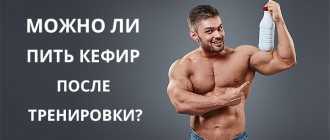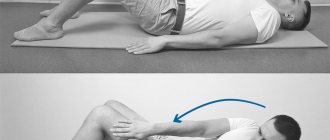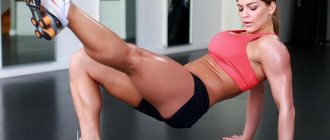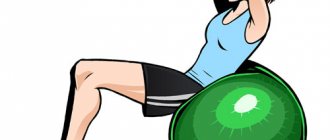Main causes of pain
If your abdominal muscles hurt after a workout, then this symptom can have only a few reasons. Some of them are normal, but others can cause unpleasant consequences.
Lactic acid accumulation
This is the most common cause of abdominal pain after exercise. The fact is that during intense exercise performed without a sufficient flow of oxygen into the body, lactic acid is produced as a result of biochemical reactions. And during the exercise, acid accumulates in those muscles that participated in the exercises.
And it is this lactic acid that does not cause severe pain. When your muscles feel like they're on fire a little. But such sensations usually do not last long - about half an hour after the end of the workout.
During training there will definitely be muscle pain, it is important to understand what the cause is
It is almost impossible to do anything about the process of accumulation of lactic acid, since this is a feature of our body. You can only let more fresh air into the gym during training to increase oxygen availability. And during approaches, try to breathe correctly so that this oxygen enters the lungs.
Read more about the phenomenon of muscle soreness >>
However, with strength training it is impossible to achieve the same effect as with cyclic exercises on the street, so you can only minimize unpleasant pain.
Atypical loads
Such pain appears if you have not exercised at all for a long time, or have started doing some new set of exercises to which your muscles have not yet adapted, notes hudeem-bez-problem.ru.
During intense exercise, muscles that do not yet have the necessary elasticity begin to receive micro tears, which leads to soreness.
In order to reduce post-workout abdominal pain caused by this reason, try to follow these rules:
- the load should increase gradually,
- between workouts, muscles should receive the necessary rest,
- Before starting a class, be sure to take time to warm up and stretch your muscles.
Overvoltage
This reason for sore abdominal muscles after training is most often found among inexperienced athletes. They try to exercise more intensely, thinking that this will lead to better results. But you shouldn’t do this, because if you overstrain your muscles, you may not get a positive effect from the exercise at all.
It is very important to understand what happens to your body during training and why your muscles need periodic rest. After all, if you don’t distribute exercises across different muscle groups, but work, for example, only one abs, then the muscles in this area will become “clogged.”
Calculate your strength and follow the exercise technique
Incorrect exercise technique
The athlete must have a good understanding of the technique of each specific exercise in order to perform it as correctly as possible.
To ensure that each workout goes well and effectively, it is best for a beginner to start with several sessions under the supervision of an experienced trainer.
How many such sessions are required depends only on your ability to perceive information. For some, one training session is enough, during which the trainer talks in detail about the technique of performing the exercises. And others need more time.
No hitch
Not only the warm-up is important for the proper construction of the training process, but also the cool-down. Stretching after finishing a strength training session helps your muscles relax. And this leads to a decrease in pain.
Upper press
When you pump your upper abs while lying on the mat, you must remember that your chin should not be pressed to your chest; on the contrary, the distance between the upper chest and chin should be the size of a tennis ball. Keep an eye on this all the time.
The correct position of the hands is also important - they should only lightly touch the back of the head, and in no case should you put pressure on the back of the head with your hands. This common beginner mistake can lead to overexertion.
Concentration should be on the muscles that you are pumping. If you think about something extraneous, then the work of the press can be taken over by other auxiliary muscles (the same muscles of the neck). Hence the tense red face - with the correct technique, the muscles of the face and neck should not tense.
How to understand that the cause of pain is an abdominal injury?
It is very rare that injury is the cause of abdominal pain after training, but knowing what to do in this case is important for every athlete. You will recognize the injury easily - the pain in the press will be quite strong and sharp, and may radiate to the ribs. You are most likely to be injured in the following situations:
- incorrect approach technique,
- irrational load on various muscle groups,
- no warm-up has been done, so the muscles are not warmed up.
What do experienced athletes advise you to pay attention to? Firstly, the nature of the pain. With abdominal injuries, the pain is mainly of a pulsating nature. In this case, hematomas and bruises may appear in the abdominal area. This means that the muscles did not have time to fully recover, and due to overload, the fibers began to tear.
Don’t lie around after training, it’s better to do a cool-down - stretch your abdominal muscles and others
You should visit a doctor as soon as possible if you have a “hernia bulge,” advises hudeem-bez-problem.ru. Then, when this hernia is strangulated, increased pressure occurs on the internal organs. If you delay going to the doctor, you may well end up with tissue necrosis.
How to avoid lower back pain when working out your abs
First, monitor the health of your spine: if you do not have protrusions, hernias or osteochondrosis, the chance that you will experience back discomfort when training your abs is small.
Secondly, you need to control the technique of doing the exercises. “When performing abdominal exercises, it is important to understand the functions of the abdominal muscles and their modes of operation. Conventionally, all abdominal exercises can be divided into two groups: static and dynamic,” explains Yulia Malenchuk. — Static means tensing the muscles without changing their length with an emphasis on maintaining the position of the lower back - this is how the abdominal muscles should work in terms of their role in our body: they, first of all, support the position of the lower back when performing various movements. This includes all types of planks, even dynamic ones, since movements in them should be performed not with the back, but with the limbs, as well as all kinds of leg movements with a stationary lower back: for example, “scissors.” Such exercises use both external and internal muscles.”
Experts also advise choosing abdominal exercises that are safer for the lower back. “Safer, but no less effective exercises are my favorite crunches on a fitball, “prayer” on a block, crunches on the floor and plank,” says Sergei Artyushenko.
Follow these guidelines to strengthen your abs without lower back discomfort.
How to relieve pain?
It all depends on the cause of the pain.
It is clear that in case of injury you do not need to self-medicate, but should visit a specialist.
And if lactic acid accumulates, it’s easier to just wait it out for a while rather than try to do something about the unpleasant sensations. But there is a list of fairly universal tips that help reduce discomfort in the press after training.
- Drink soda before classes. This method will help increase your pain threshold before starting a workout. It is enough to mix half a teaspoon with a glass of water and drink this drink. Blood acidity will drop, and the pain threshold will increase slightly. But keep in mind that for some diseases this cannot be done.
- Eat healthy and varied. Not all athletes adhere to this principle, especially when they are cutting. But be prepared for the fact that a lack of useful elements leads to increased pain.
- Take ascorbic acid and beta-alanine. Everyone knows about the benefits of vitamin C or ascorbic acid. Start with a dosage of 1 g post-workout. The natural amino acid beta-alonine is no less important for an athlete, as it helps restore muscle mass and increase it.
- Drink enough water. This helps to quickly remove all breakdown products from the body and speed up recovery processes.
- Conduct the training correctly. In particular, do a warm-up and cool-down so that the muscles receive the necessary stretch and their fibers are less torn.
- Periodically give your body proper rest. And this applies not just to lying on the couch, but to procedures such as baths and saunas, spa treatments or just a contrast shower. All this improves blood circulation and relaxes muscles well.
- Include Omega-3 fatty acids in your diet. These acids have an anti-inflammatory effect, so they help speed up the process of muscle tissue recovery.
- Get enough sleep. On average, the body requires 7–8 hours of full sleep to fully recover.
Relieving abdominal pain with ointments
There are many ointments and gels that will help either reduce pain or even get rid of abdominal pain after training. All these funds are divided into several categories.
If the pain is severe, use painkillers
Non-steroidal anti-inflammatory gels
They help reduce pain and relieve swelling of the press. But it is advisable to use these ointments after a doctor’s prescription. Made on the basis of the following active ingredients:
- Diclofenac,
- Piroxicam,
- Indomethacin,
- Nimesulide,
- Ibuprofen,
- Ketoprofen.
Warming ointments
This type of ointment increases blood circulation in the damaged abdominal area and reduces pain. They can also be used for injuries, but only after a doctor’s prescription. They are usually made on the basis of capsaicin, so such ointments should be applied to the skin, but not rubbed.
Ointments and gels will relieve muscle pain - follow the dosage
Most popular:
- Kapsikam,
- Ben-Gay,
- Finalgon,
- Nicoflex,
- Apizartron.
What causes your abs to hurt?
There are not many reasons for post-workout muscle soreness. But among them there are those who should not be feared. And those that need to be treated with caution and perhaps consult a specialist.
First reason
Perhaps, after reading the title, many of you will remember the song by Igor Nikolaev. But the first reason is completely different - this is not a typical muscle load. This happens when you start to load your overtrained muscles. For example, after a long break from training or coming to the gym for the first time. This pain is not dangerous and is caused by microtraumas of muscle fibers, which are the body's normal response to heavy loads.
The second reason
When you and I train our abs, biochemical reactions occur in our muscles. One of them is the production of energy to fuel muscles. But every reaction has by-products. In our case it is lactic acid. It is this that causes a burning sensation in the stomach during training and can persist after stopping the approach for some time (no more than 30 minutes). True, after a half-hour period, there will be no trace left of it. Therefore, she is not to blame for abdominal muscle pain the day after training.
Third reason
If you feel severe pain after training, then this is a reason to be wary. Of course, the abs can hurt a lot for the first reason, but if it is pulsating or does not go away for several days, this is a reason to consult a doctor. Training should be stopped until the circumstances are clarified!











